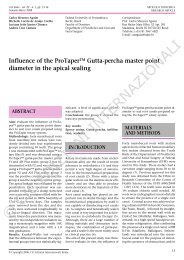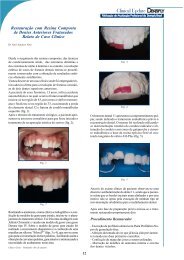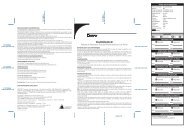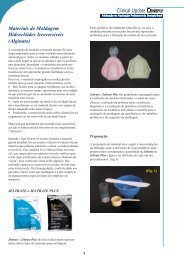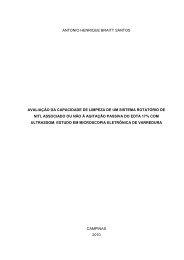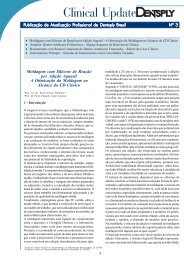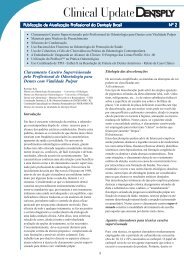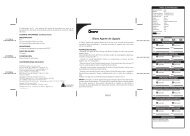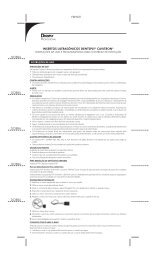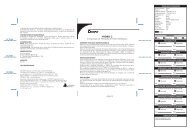Create successful ePaper yourself
Turn your PDF publications into a flip-book with our unique Google optimized e-Paper software.
Raffaelli et al<br />
Table 2 Bond strength values obtained luting 3-mm-thick<br />
porcelain disks. n=sample size (in parentheses, number<br />
of premature failures), mean, and standard deviation (SD)<br />
values excluding premature failures. Premature failures<br />
were excluded from the statistical analysis<br />
Group N Mean (MPa) SD<br />
1. (control): 42 (7) 20.9 BC 10<br />
PBNT LC +<br />
Calibra DC<br />
2. XP LC + 53 (8) 24.9 AB 10.7<br />
Calibra DC<br />
4. XP + SCA + 37 (4) 29.8 A 12.9<br />
Calibra DC<br />
According to the post-hoc test, XP+SCA+Calibra DC achieved a significantly<br />
higher bond strength than group 1. Groups with the same uppercase<br />
letter are not statistically significantly different.<br />
Table 3 Bond strength values obtained luting 2-mm-thick<br />
porcelain disks. n=sample size (number of premature failures<br />
in parentheses), mean and standard deviation (SD)<br />
values excluding premature failures. Premature failures<br />
were excluded from the statistical analysis<br />
Group N Mean (MPa) SD<br />
3. XP+ SCA + 35 (4) 23.6 AB 11.1<br />
Calibra DC<br />
6. XP + SCA + 37 (6) 28.6 A 10.4<br />
Calibra CC<br />
7. Syntac No LC 20 (17) 17.1 B 6.6<br />
+ Calibra CC<br />
According to the post-hoc test, XP+SCA (No LC)+Calibra CC achieved a<br />
significantly higher bond strength than Syntac No LC+Calibra CC.<br />
Groups with the same uppercase letter are not statistically significantly<br />
different.<br />
Table 4 Bond strength values recorded using 3 different porcelain thicknesses.<br />
n=sample size (number of premature failures in parentheses), mean and standard<br />
deviation values excluding premature failures. Premature failures were excluded<br />
from the statistical analysis<br />
Ceramic Adhesive/ n Mean (MPa) SD<br />
thickness resin cement<br />
Group 3: XP+SCA+Calibra 35 (4) 23.6 B 11.1<br />
2 mm DC<br />
Group 4:<br />
3 mm 33 (4) 29.8 AB 12.1<br />
Group 5:<br />
4 mm 43 (10) 30.3 A 12.3<br />
According to the post-hoc test, the bond strengths measured with 4-mm-thick disks were significantly<br />
higher than those measured with 2-mm-thick disks. Groups with the same uppercase letter are not statistically<br />
significantly different.<br />
Groups 4, 5, and 6 showed the highest bond strength values.<br />
In these three groups, the XP BOND was not light cured<br />
before seating the ceramic onlay, and in group 6 Calibra was<br />
chemically cured. When comparing the groups that differed<br />
in ceramic onlay thickness, it was noted that the specimens<br />
obtained from 4-mm-thick onlays (group 5) showed the highest<br />
bond strength but also a higher percentage of pretest<br />
failure.<br />
SEM observations showed that adhesive fracture was<br />
the most common failure type in groups 2 to 7. Only in group<br />
1 were two cohesive failures in dentin and two mixed failures<br />
recorded.<br />
DISCUSSION<br />
The microtensile evaluation performed in this study was<br />
used in order to standardize the bond strength test and evaluate<br />
two different variables, the restorative material thickness<br />
and the curing mode of the adhesive-luting agent combinations.<br />
In order to properly apply the statistical analysis,<br />
it was decided to report the number of premature failures in<br />
the tables without including them in the analysis. Only in<br />
group 7 was the number of premature failures rather high<br />
(45%). In the other groups, the percentage of premature failures<br />
was 10% to 19%. The occurrence of premature failures<br />
may be due to the stress transmitted at the bonding interface<br />
during the specimen reparation procedure.<br />
Vol 9, Supplement 2, 2007 277



